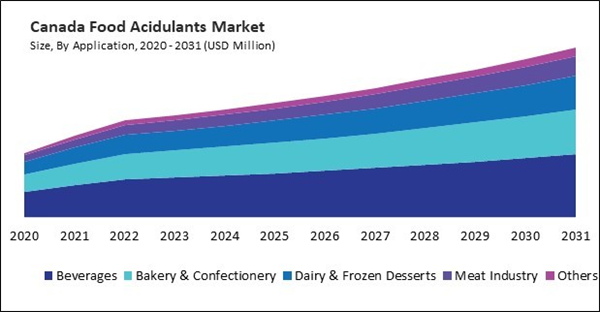Citric acid, a prominent type of food acidulant, holds a significant position in various industries, including food and beverage, pharmaceuticals, and cosmetics, owing to its versatile applications, distinct advantages, and evolving market trends. Primarily used as a flavor enhancer and preservative, citric acid plays a crucial role in imparting a tangy taste and extending the shelf life of numerous food and beverage products, ranging from carbonated drinks and fruit juices to candies and canned goods. Consequently, the US market consumed 1,032.0 tonnes of citric acid in 2023.
The US market dominated the North America Food Acidulants Market by Country in 2023, and is forecast to continue being a dominant market till 2031; thereby, achieving a market value of $1.79 billion by 2031. The Canada market is experiencing a CAGR of 6.7% during (2024 - 2031). Additionally, The Mexico market would exhibit a CAGR of 5.8% during (2024 - 2031).
Acidulants serve as natural preservatives by inhibiting the growth of bacteria and fungi that could cause food to degrade. They extend the shelf life of perishable food products such as bakery items (bread, cakes, pastries), dairy products (yogurt, cheese), and meat products (sausages, cured meats). In bakery applications, acidulants condition dough, improving its texture, elasticity, and rise. They help achieve desirable characteristics in baked goods such as bread, rolls, and pastries.
Moreover, acidulants are utilized in fermentation processes to create acidic environments conducive to the growth of beneficial microorganisms. They play a role in fermenting foods like yogurt, cheese, sauerkraut, and sourdough bread. Acidulants are added to marinades and brine to tenderize meat, poultry, and seafood and enhance flavor penetration.
The need for acidulants will increase with Mexico's food processing industry's growth. Acidulants are essential ingredients in food processing for various purposes, including flavor enhancement, preservation, pH regulation, and texture improvement. The growing production of processed foods such as snacks, beverages, sauces, and canned goods will drive the need for acidulants in Mexico. The food processing sector in Mexico was one of the most active in the nation, with an average annual growth rate of 4.3%, according to the US Department of Agriculture. Hence, the region's rising food and beverage industry is driving the market's growth.
List of Key Companies Profiled
- Tate & Lyle Plc
- Brenntag SE
- Univar Solutions, Inc.
- Archer Daniels Midland Company
- Jungbunzlauer Suisse AG
- Cargill, Incorporated
- Corbion N.V.
- Bartek Ingredients Inc. (TorQuest Partners)
- FBC Industries Inc.
- Hawkins Watts Limited
Market Report Segmentation
By Application< (Volume, Tonnes, USD Billion, 2020-2031)- Beverages
- Bakery & Confectionery
- Dairy & Frozen Desserts
- Meat Industry
- Others
- Citric Acid
- Acetic Acid
- Lactic Acid
- Phosphoric Acid
- Malic Acid
- Others
- US
- Canada
- Mexico
- Rest of North America
Table of Contents
Companies Mentioned
- Tate & Lyle Plc
- Brenntag SE
- Univar Solutions, Inc.
- Archer Daniels Midland Company
- Jungbunzlauer Suisse AG
- Cargill, Incorporated
- Corbion N.V.
- Bartek Ingredients Inc. (TorQuest Partners)
- FBC Industries Inc.
- Hawkins Watts Limited
Methodology

LOADING...









